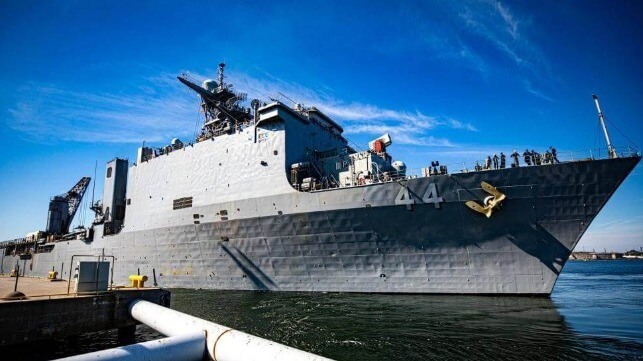U.S. Navy Gets $11B Budget Boost, Plans to Cut Amphib Fleet

The U.S. Navy's budget proposal for next year reflects a shift in direction as the service reorients to meet the possibility of high-end conflict in the Pacific. It puts a premium on readiness, maintenance, and long-range strike - at the expense of overall fleet size and less-wanted vessels.
For everyday scheduled maintenance, the service is budgeting $14 billion for 75 service availabilities. It also wants to spend $2.7 billion on its program to overhaul its four public shipyards, which are in need of deep renovation and expansion.
For construction, the request asks for nine battle force ships: one Columbia-class ballistic missile sub, two Virginia-class attack subs, two Arleigh Burke-class destroyers, two Constellation-class frigates, one oiler and one sub tender. Notably, it includes no funding for amphib procurement for FY2024, and it proposes decommissioning three of the service's 40-year-old Whidbey Island-class dock landing ships. The Navy wants to "pause" procurement on the San Antonio-class amphibs built by Ingalls Shipbuilding for a period of study, which could last for years.
Also slated for early retirement are three Ticonderoga-class cruisers and two Freedom-class littoral combat ships, a perennial request for the service. Congress has repeatedly scaled back or turned down the Navy's requests to retire these vessel classes, which have higher operating costs and (according to the Navy) less value for the high-end fight.
Meanwhile, the service wants to spend $2 billion extra on missile procurement, including upgrades for its oldest and longest-range weapon - the subsonic Tomahawk - and its first order for eight hypersonic Conventional Prompt Strike missiles. The CPS is a joint Army-Navy program, and in seagoing service it would be fielded first on the Zumwalt-class destroyer.

that matters most
Get the latest maritime news delivered to your inbox daily.
The Navy's priorities do not appear to align with the needs of the Marine Corps, which depends upon Navy vessels to get to and from the fight. The readiness rate for the amphib fleet - the percentage of vessels ready and able to depart port for a mission - is currently running at less than one third, according to the Marine Corps. The readiness shortfall is reason enough to keep the Whidbey Island-class hulls until replacements arrive, according to the Marine Corps' top officer.
“We can't live with a 32 percent [amphib] readiness rate. And over the last decade it’s below 50," Marine Corps Commandant Gen. David Berger told Defense One last week. "We cannot decommission [amphibs] without having the replacement in our hand. We can't do that . . . . So the decommissioning of the [Whidbey Island-class] to me is directly tied to the inventory as fast as we can procure and field. "
